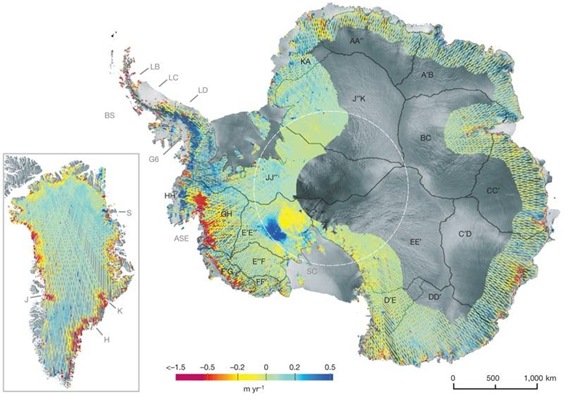Graph of the Day: Rate of Change of Surface Elevation for Antarctica and Greenland, 2003-2007
Change measurements are median filtered (10-km radius), spatially averaged (5-km radius) and gridded to 3 km, from intervals (Dt) of at least 365 d, over the period 2003–2007 (mean Dt is 728 d for Antarctica and 746 d for Greenland). East Antarctic data cropped to 2,500-m altitude. White dashed line (at 81.5° S) shows southern limit of radar altimetry measurements. Labels are for sites and drainage sectors (see text). Prominent in Greenland is the strong thinning of the southeast and northwest ice-sheet margins (Supplementary Fig. 3); higher areas in the south thickened. These margins have a positive surface mass balance (SMB) and, hence, a high proportion of discharge through tidewater glaciers. Southeastern glaciers accelerated between 1996 and 2005, but those in the northwest showed little change in flow2. The widespread dynamic thinning we identify in the northwest therefore implies a sustained period of dynamic imbalance. For the ice sheet as a whole, areas of fast flow1 (>100 m yr-1 (ref. 2)) thinned significantly more rapidly than slow-flowing areas (0.84 m yr-1 versus 0.12 m yr-1), a discrepancy that cannot be explained by variability in SMB (Supplementary Table 2). We find that of 111 glaciers surveyed, 81 thinned dynamically at rates greater than twice the thinning rate on nearby slow-flowing ice at the same altitude (Supplementary Tables 5 and 6). … In Antarctica, we find significant dynamic thinning of fast-flowing ice at rates greater than plausible through interannual accumulation variability for drainage sectors19 F’G and GH (Fig. 2), with significant dynamic thickening of sector A’B (Supplementary Table 4). On the glacier scale, thinning is strongest in the Amundsen Sea embayment (ASE), where it is confirmed as being localized on the fast-flowing glaciers and their tributaries (Fig. 3 and Supplementary Fig. 7). The area close to the Pine Island Glacier grounding line thinned in the period 2003–2007 at up to 6 m yr-1, neighbouring Smith Glacier thinned at a rate in excess of 9 m yr-1 and Thwaites Glacier thinned at a rate of around 4 m yr-1. These rates are higher than those reported for the 2002–2004 period20. Numerous small, independent glaciers feeding the same, rapidly thinning ice shelves, namely the Crosson and Dotson ice shelves21, are also thinning dynamically, which is strong evidence of a common, ocean-driven cause (Supplementary Fig. 7). Surface lowering is apparent across almost the whole area of the drainage basins of the Kohler, Smith, Pope and Haynes glaciers of the Amundsen Sea embayment, and up to the northern drainage divide of Pine Island Glacier. We calculate the mean elevation rate for sector GH to be -0.139 ± 0.07 m yr-1 (whereas a rate of -0.092 ± 0.007 m yr-1 was reported for 1995–200322), giving a volume change of -57 ± 29 km3 yr-1. …
Hamish D. Pritchard, Robert J. Arthern, David G. Vaughan & Laura A. Edwards, Extensive dynamic thinning on the margins of the Greenland and Antarctic ice sheets, Nature advance online publication 23 September 2009, doi:10.1038/nature08471
